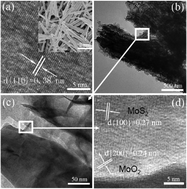In situ synthesis and high adsorption performance of MoO2/Mo4O11 and MoO2/MoS2 composite nanorods by reduction of MoO3†
Abstract
MoO2/Mo4O11 and MoO2/MoS2 composite nanorods were successfully synthesized by reducing MoO3 nanorods. The adsorption performance of samples was evaluated by using Rhodamine B (RhB) and metal ions in aqueous solutions as the targets. The results indicated that the obtained MoO2/Mo4O11 and MoO2/MoS2 composite nanorods can present excellent adsorption performance. The BET surface areas of samples increased with increasing the MoO3 : S mass ratio. The adsorption kinetics for the RhB and Cu2+ ions on the composite nanorods were well fitted to a pseudo-second order model.


 Please wait while we load your content...
Please wait while we load your content...